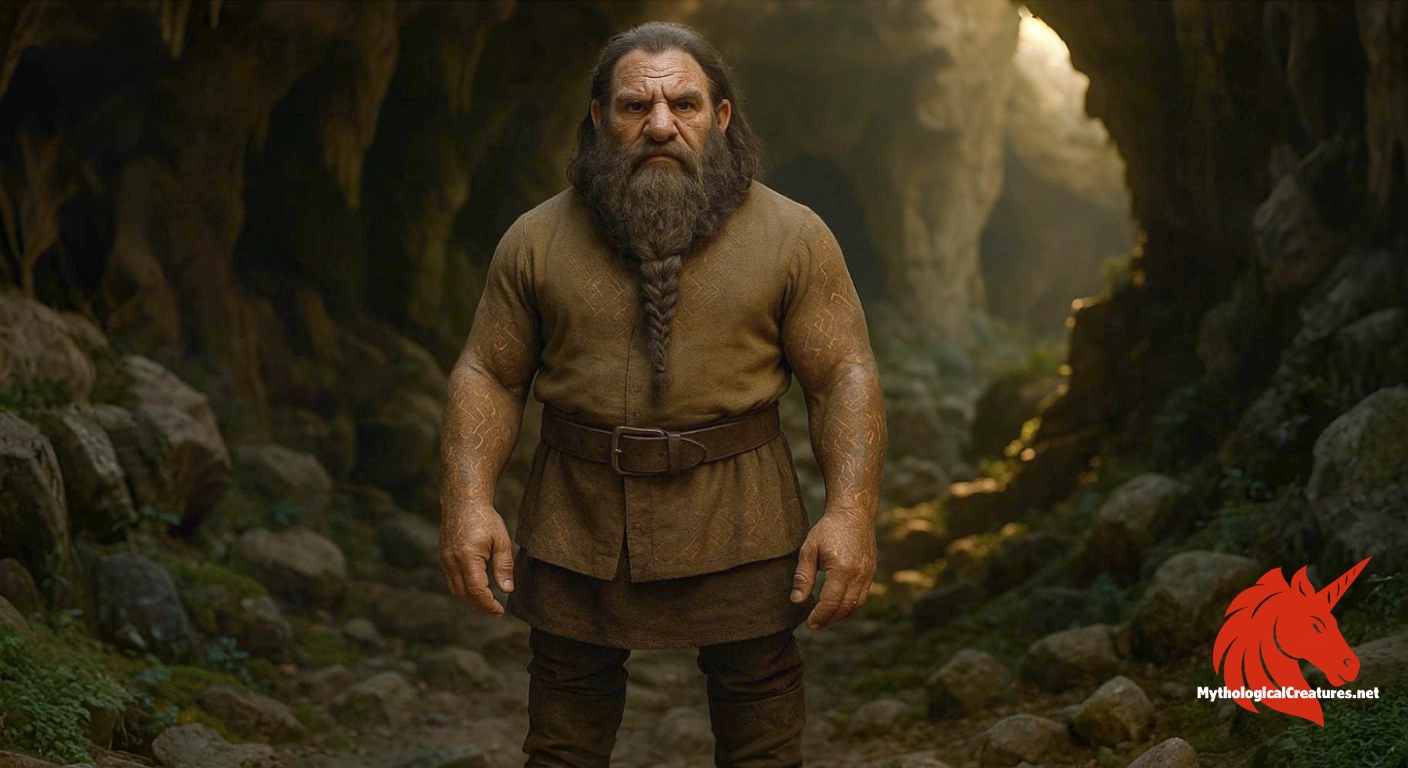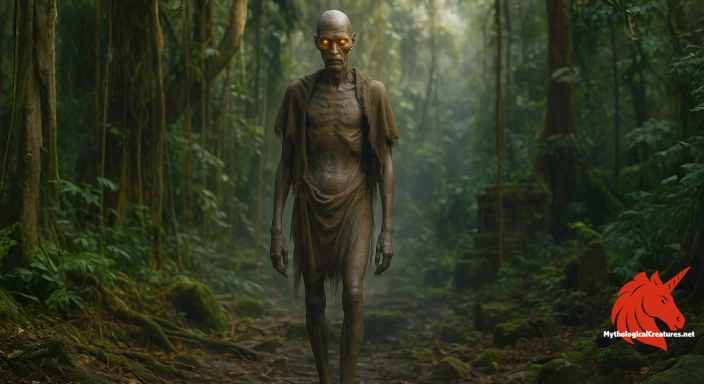Alvíss: Alvíss, meaning 'All-Wise', is a dwarf from Norse mythology renowned for his exceptional intellect.

Alvíss
Alvíss - Alvíss embodies themes of wisdom and the inexorable limits imposed by nature, as his petrification at dawn underscores that even the all-wise are not immune to fate.
Origins & First Encounters
Alvíss, whose name translates as 'All-Wise', is a figure of both admiration and melancholy in Norse myth, embodying a deep reservoir of esoteric knowledge within his diminutive form.
Emerging most notably in the medieval poem Alvíssmál from the Poetic Edda, his narrative intertwines wit with the inevitabilities imposed by the gods.
The mythic account reveals him as a dwarf, a race often celebrated for their secret lore and master craftsmanship, yet his specific legacy rests on his encyclopaedic wisdom.
Central to his tale is the ill-fated betrothal with Thor’s daughter, an engagement that sets the stage for an ingenious contest of intellect.
The spirit of his story is further defined by the merciless hand of destiny, as his wisdom is ultimately overwhelmed by the relentless power of divine authority.
This narrative not only illustrates the Norse valuation of knowledge but also underscores the harsh boundaries that even great intellect cannot transcend within the mythical cosmos.
Alvíss is portrayed as a being whose extensive learning is both an asset and a liability, a paradox that has captivated audiences for centuries.
His origin in a world where mortals interact with gods speaks to a broader cultural narrative that celebrates wisdom while cautioning against its potential for hubris.
The enduring allure of his legend lies in the way it synthesises admiration for sagacity with the inevitable limitations imposed by nature.
Source Texts & Tale Variants
The principal source attesting to Alvíss’s myth is the poem Alvíssmál, a vital component of the Poetic Edda that encapsulates the rich oral traditions of medieval Scandinavia.
This literary piece presents his story not as a linear narrative but as a series of dialogues that serve to display his formidable store of lore.
The poem’s structure, with its rhythmic exchange of riddles and wisdom, reflects a deep tradition of schooled debate and intellectual display in Norse culture.
Other ancient texts and later compilations provide sparse references to him, yet none capture the essence of his cunning as vividly as Alvíssmál does.
Fragments of his tale also emerge in broader dwarf lore, hinting at a shared narrative space among the subterranean beings of the North.
In some medieval manuscripts, minor variations in his tests and final fate indicate the fluidity of oral tradition influenced by regional storytelling practices.
The transmission of his myth through generations highlights the adaptability of the narrative, allowing each reciter to emphasise different aspects of his wisdom and folly.
These primary and secondary sources collectively attest to a character who, while singular in detail, represents a broader archetypal wisdom challenged by divine imperatives.
Taken together, they form a mosaic of tradition that has preserved and adapted his myth for centuries.
Form & Powers
Though detailed physical descriptions of Alvíss are sparse in the surviving texts, later interpretations paint him as a small, wiry figure whose physical diminutiveness belies his vast internal knowledge.
His appearance is often envisioned as that of a typical dwarf in Norse lore, with a modest stature and a robust, weathered countenance that suggests a life spent in the depths of the earth.
The features attributed to him tend to include keen, glittering eyes that hint at both intelligence and a touch of divine mischief.
Imagery from subsequent artistic renditions portrays him with a firm set jaw and an expression full of contemplative resolve, emphasising his role as a keeper of ancient lore.
Noteworthy is the subtle interplay between his unassuming physical form and the monumental nature of his wisdom, a contrast that is celebrated in mythic symbolism.
His attire is typically imagined as simple but practical, possibly adorned with motifs that echo the intricate craftsmanship of dwarf culture.
The interplay of light and shadow in his depictions—often highlighted by the critical moment of his petrification at sunrise—further underscores the delicate balance between his physical limitations and his intellectual brilliance.
The limited physicality of Alvíss serves as a narrative reminder of the natural laws that even the sagacious must eventually succumb to.
In this way, his appearance is as much a reflection of his narrative purpose as it is a testament to the aesthetic values of Norse myth.
Regional Faces
While the most comprehensive account of Alvíss originates from the Icelandic tradition, his myth also found echoes throughout other regions of Scandinavia.
In Norway and Denmark, local interpretations of his story have occasionally shifted focus, highlighting different aspects of his character such as the sanctity of wisdom or the tragic hubris of challenging the divine.
Some regional variants cast his encounter with Thor more as a battle of wits, emphasising the clever tactics employed by the gods to subdue even the most formidable of intellects.
These adaptations often reflect the particular cultural and social values of their locales, such as the importance of humility in the face of cosmic power.
In certain traditions, the dwarf’s role as a custodian of arcane knowledge is further intertwined with local legends involving other enigmatic subterranean beings.
Localized folklore occasionally incorporates unique elements, portraying his wisdom as a metaphor for the hidden riches of the natural world.
This regional variation not only enriches the character of Alvíss but also underlines the flexible nature of myth in adapting to different cultural landscapes.
The diversity of his portrayals across Scandinavia illustrates how shared mythical motifs can be reimagined to align with distinct local ethos and beliefs.
Thus, the regional adaptations of his myth continue to foster an enduring dialogue between the ancient past and the evolving cultural sensibilities of the North.
Cultural Parallels
The myth of Alvíss resonates with the broader archetype of the wise, yet ultimately vulnerable, sage found in many mythological traditions around the world.
His character, though rooted in the Norse landscape, invites comparisons with similar figures in other cultures who embody the paradox of immense knowledge contained within a physically limited form.
For instance, the dwarfs of Germanic legend and the cunning fae of Celtic lore often share traits of extraordinary intellect coupled with a corporeal frailty that renders them subject to the whims of nature and divinity.
In these cross-cultural narratives, the wisdom of such beings is both revered and feared, echoing the universal motif that even the most learned can fall victim to larger cosmic forces.
This comparative lens illuminates a recurring theme: that knowledge, however vast, must eventually bow to the inevitable constraints imposed by the natural world.
The interplay of intellect and limitation is a story as old as myth itself, one that bridges the narratives of distinct cultures while celebrating their common human concerns.
Other traditions, including various Eastern legends, also celebrate characters who, like Alvíss, are ensnared by the delicate balance between brilliance and vulnerability.
The universal appeal of this archetype lies in its reflection of the human condition, where the pursuit of wisdom is invariably tempered by the realities of mortality.
Thus, Alvíss stands not only as a uniquely Norse figure but also as a part of an enduring global mythological tapestry that links disparate cultures through shared themes of intellectual ambition and cosmic order.
Legacy & Modern Evolution
The legacy of Alvíss extends far beyond the confines of medieval manuscripts, influencing modern interpretations of myth and the depiction of dwarfs in contemporary culture.
His tale, emblematic of the fine line that separates brilliance from downfall, has found new life in modern fantasy literature and art, where the interplay between intellect and physical limitation is a recurring motif.
Contemporary retellings often highlight his enduring struggle against the inexorable forces of the divine, transforming his story into a metaphor for the challenges faced by those who dare to defy predetermined roles.
The narrative of his petrification at sunrise has been reimagined in various media as a striking allegory for the transient nature of wisdom when confronted with the relentless progress of time.
Modern adaptations, including films, graphic novels and role-playing games, draw on the rich tapestry of his myth to explore themes of existential vulnerability and the paradox of power.
This evolution in his portrayal reflects a broader shift in how ancient myths are appropriated to comment on contemporary issues such as the limits of technology and the fleeting nature of human achievement.
His enduring influence is seen in the revived interest in Norse myth, which continues to inspire a generation fascinated by the interplay between humanity and the divine.
The story of Alvíss remains a poignant reminder of the complexities inherent in the search for knowledge and the inevitable sacrifices that such a quest entails.
In modern scholarship and popular culture alike, Alvíss is celebrated as both a cautionary figure and an emblem of timeless curiosity, his myth a bridge between a storied past and an ever-changing present.
Interesting Fact
Despite being celebrated for his vast wisdom, Alvíss is ultimately undone by a natural element as commonplace as sunlight, illustrating a fascinating irony in Norse mythology.
Quick Creature Info
Origin:
Associations:
Our Mythic Legendary Rating:

Habitat:
Supernatural Powers:
Physical Attributes:
Abilities:
Behavior:
Weaknesses:
Lore:
References
Discover Another Mythical Legend You May Not Have Heard Of?
Uncover the mysteries of ancient folklore and expand your knowledge of legendary beings from cultures around the world.
Dare to Meet the Obambo....
Curated by the Mythological Creatures Team (rev. May 2025)
